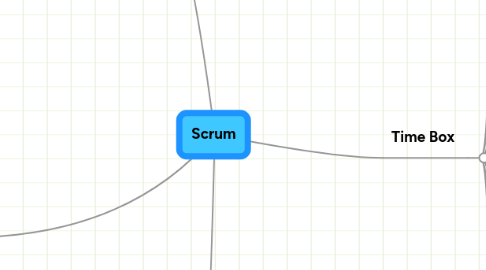
1. Scrum Team
1.1. Scrum Master
1.1.1. Not Product Owner
1.1.2. Coaches
1.1.3. Does not manage team
1.1.4. Ensures adherence
1.1.5. Ensures adoption
1.1.5.1. Team
1.1.5.2. Organisation
1.1.6. Enforce discipline in Daily Scrum
1.2. Product Owner
1.2.1. One Person
1.2.2. Maintains Product Backlog
1.2.2.1. Manage Priorities
1.2.2.2. Create visibility
1.2.3. Ensures value is delivered
1.2.4. Authority to cancel sprint
1.3. Team
1.3.1. Self Organising
1.3.2. No subteams allowed
1.3.3. Collectively responsible for estimates
1.3.4. Converts backlog to shippable
1.3.5. Authority to change sprint backlog with Product Owner
1.3.6. 7 +/- 2 people
1.3.7. No titles
1.3.8. Determines sprint backlog
1.3.9. All should code
1.3.10. Members don't change during sprint
2. Artifact
2.1. Sprint Burndown
2.1.1. Chart
2.1.2. Remaining sprint backlog estimate over time
2.1.3. Tick = 1 day
2.2. Release Burndown
2.2.1. Chart
2.2.2. Remaining product backlog estimate over time
2.2.3. Tick = 1 sprint
2.3. Product Backlog
2.3.1. Items
2.3.1.1. User Story
2.3.1.2. Description
2.3.1.3. Priority
2.3.1.4. Estimate
2.3.2. Product Requirements
2.3.3. Never Complete
2.3.4. Evolves
2.3.5. 10% of Sprint spent grooming
2.4. Sprint Backlog
2.4.1. Tasks remaining in Sprint
2.4.2. Created in Sprint Planning Meeting
3. Done
3.1. Potentially shippable
3.2. Workable slice
3.3. Team decides definition
4. Time Box
4.1. Release Planning Meeting
4.1.1. Establish
4.1.1.1. Plan
4.1.1.2. Goal
4.1.2. Determine How
4.1.3. Produces Release Plan
4.1.4. JIT Planning
4.1.5. Identify
4.1.5.1. Goals
4.1.5.2. Risks
4.1.5.3. Features
4.1.5.4. Priority
4.2. Sprint
4.2.1. Iteration
4.2.2. Change scope with Product Owner
4.2.3. No time between sprints
4.2.4. Approximately 1 month
4.2.5. Team composition and goal remain fixed
4.3. Sprint Planning Meeting
4.3.1. Inputs
4.3.1.1. Past performance
4.3.1.2. Capacity
4.3.1.3. Latest increment of product
4.3.1.4. Product backlog
4.3.2. Parts
4.3.2.1. 4 Hours: What
4.3.2.1.1. Sprint Goal
4.3.2.2. 4 Hours: How
4.3.2.2.1. Design
4.3.2.2.2. Tasks
4.3.3. Iteration is planned
4.3.4. Product owner present
4.4. Sprint Review
4.4.1. End of sprint
4.4.2. Review state of product backlog
4.4.3. 4 hours
4.4.4. Pigs and Chickens
4.4.5. What's next
4.4.6. Informal
4.4.7. What's done / what's not done
4.4.8. Demo and Q & A
4.5. Daily Scrum
4.5.1. Not a status meeting
4.5.2. 15 minutes
4.5.3. Same time and place
4.5.4. Explain
4.5.4.1. What is done
4.5.4.2. What is not done
4.5.4.3. Obstacles
4.5.5. Inspection of progress toward goal
4.6. Retrospective
4.6.1. 3 hours
4.6.2. Post sprint review
4.6.3. Pre sprint planning
4.6.4. Revise development process
4.6.4.1. Tools
4.6.4.2. Process
4.6.4.3. Relationships
4.6.4.4. People
4.6.5. Actionable improvement measures
4.6.6. Team composition
